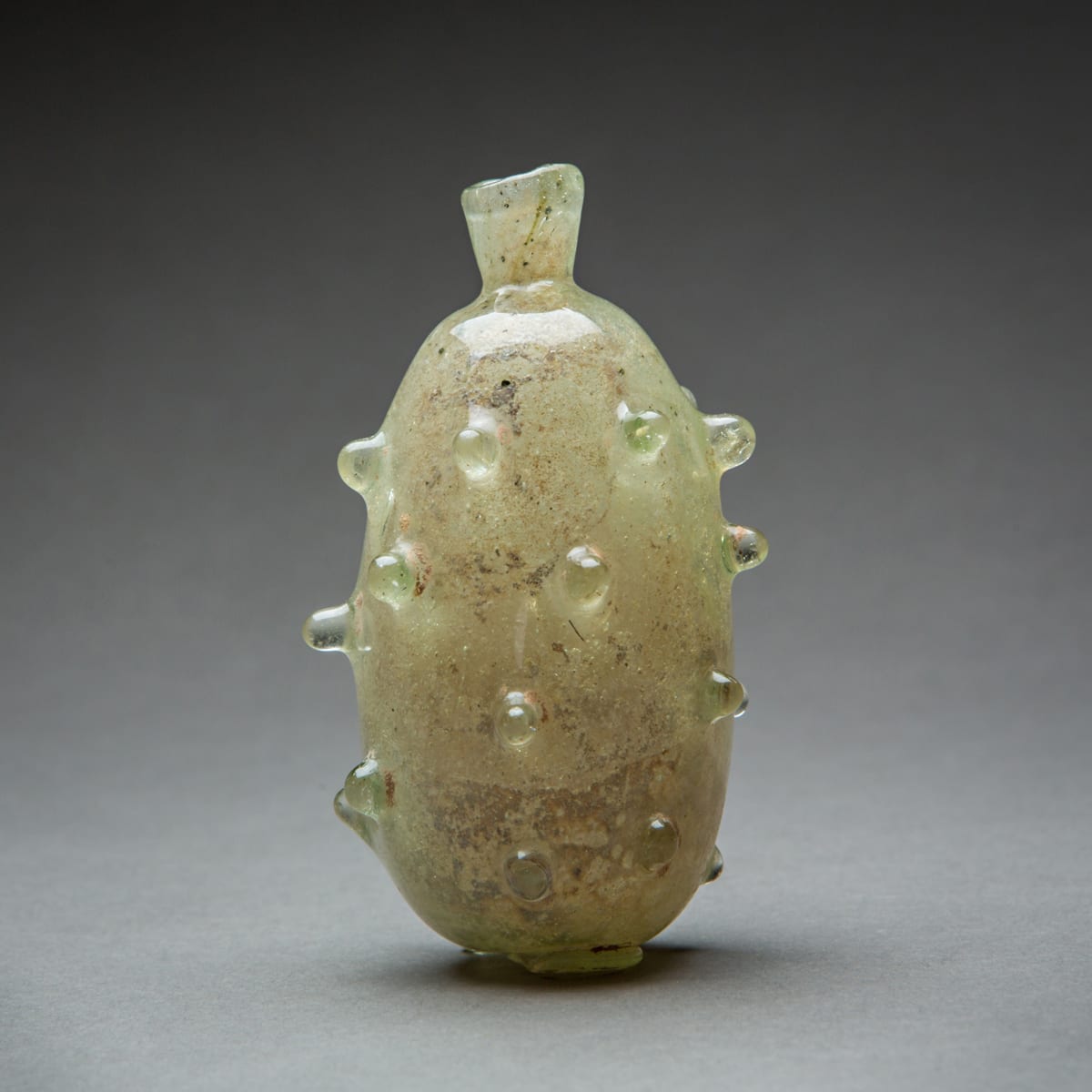Glass Bottle, 700 BCE - 900 CE
hot-worked glass
7.9 x 3.8 cm
3 1/8 x 1 1/2 in
3 1/8 x 1 1/2 in
LO.912
Although the development from the pre-Islamic period to the middle of the ninth century is very recognizable in architecture, including works in stone, plaster and wood, it becomes quite blurred...
Although the development from the pre-Islamic period to the middle of the ninth century is very recognizable in architecture, including works in stone, plaster and wood, it becomes quite blurred on other media such as metalwork and pottery. Between the 5th and the 8th century glass production seems unchanged, although the surviving objects would still point to an industry that persisted and thrived, almost careless of the political and religious turmoils of the Ummayad era, including the death of the prophet Muhammad. Perhaps, the diffusion of glass-blowing and the consequent paucity of high quality glass after the crumbling of the Roman Empire might have hampered the rulers' sponsorship of glassmaking, yet during this period glass became more accessible for mundane use and thus, by loosing its status value, less attractive to affluent patrons.
Late Roman glass made along the coasts of modern Syria, Lebanon, Israel and Egypt that is usually classified as 'eastern Mediterranean” thus kept on being produced during the early Islamic period. Its features include the decoration with applied trails that could be pulled either from the same glass batch or from a different one. Applied trails were also used functionally as handles and feet; commonly the thread was patterned in zigzags or simple spirals. When trails of the same colour were used, they were manipulated with a pointed tool or a fine pincher after they were applied to the vessel. While weathering due to burial often prevents a full appreciation of the chromatic as well as the sculptural appeal of a glass vessel many have survived in excellent conditions and still convey a playful charm.
This small translucent colourless glass bottle features a small everted neck and an elongated oval body decorated throughout with small protrusions created by pinching the surface when hot. The small opening and the constricted neck of this container in which the base of the neck is almost shut would suggest its use as a sprinkler for precious liquids and perfumes. Sprinklers apparently held oil, perfume and other costly liquids. Their decoration indeed often included pinched elements such as the one encountered on our little vessel.
These protrusions were created by means of metal tongs while the vessel was still hot. Smooth tongs were used to produce pinched features such as teardrops and spikes. This technique remained in use until the 10 century AD, and it was especially popular during the 9th century in the Eastern Mediterranean area, although recent archaeological discoveries have provided evidence for the use of pinching still in the Mamluk period (14th century AD), indicating that this technique was indeed used much longer than previously thought. Small bottle or sprinkler, free-blown yellowish-green glass with oval-shaped body which is decorated with series of large prunts and rests on a raised round base and has a short opening neck.
Syria or Palestine, 7- 9th century. Ht. 7.9cm; Top diam. 1cm; Base diam. 2cm. Comparative material: Goldstein, op.cit., nos. 5, 7 and 9.
Prof.Geza Fehervar Prof. Geoffrey Kin
Late Roman glass made along the coasts of modern Syria, Lebanon, Israel and Egypt that is usually classified as 'eastern Mediterranean” thus kept on being produced during the early Islamic period. Its features include the decoration with applied trails that could be pulled either from the same glass batch or from a different one. Applied trails were also used functionally as handles and feet; commonly the thread was patterned in zigzags or simple spirals. When trails of the same colour were used, they were manipulated with a pointed tool or a fine pincher after they were applied to the vessel. While weathering due to burial often prevents a full appreciation of the chromatic as well as the sculptural appeal of a glass vessel many have survived in excellent conditions and still convey a playful charm.
This small translucent colourless glass bottle features a small everted neck and an elongated oval body decorated throughout with small protrusions created by pinching the surface when hot. The small opening and the constricted neck of this container in which the base of the neck is almost shut would suggest its use as a sprinkler for precious liquids and perfumes. Sprinklers apparently held oil, perfume and other costly liquids. Their decoration indeed often included pinched elements such as the one encountered on our little vessel.
These protrusions were created by means of metal tongs while the vessel was still hot. Smooth tongs were used to produce pinched features such as teardrops and spikes. This technique remained in use until the 10 century AD, and it was especially popular during the 9th century in the Eastern Mediterranean area, although recent archaeological discoveries have provided evidence for the use of pinching still in the Mamluk period (14th century AD), indicating that this technique was indeed used much longer than previously thought. Small bottle or sprinkler, free-blown yellowish-green glass with oval-shaped body which is decorated with series of large prunts and rests on a raised round base and has a short opening neck.
Syria or Palestine, 7- 9th century. Ht. 7.9cm; Top diam. 1cm; Base diam. 2cm. Comparative material: Goldstein, op.cit., nos. 5, 7 and 9.
Prof.Geza Fehervar Prof. Geoffrey Kin



